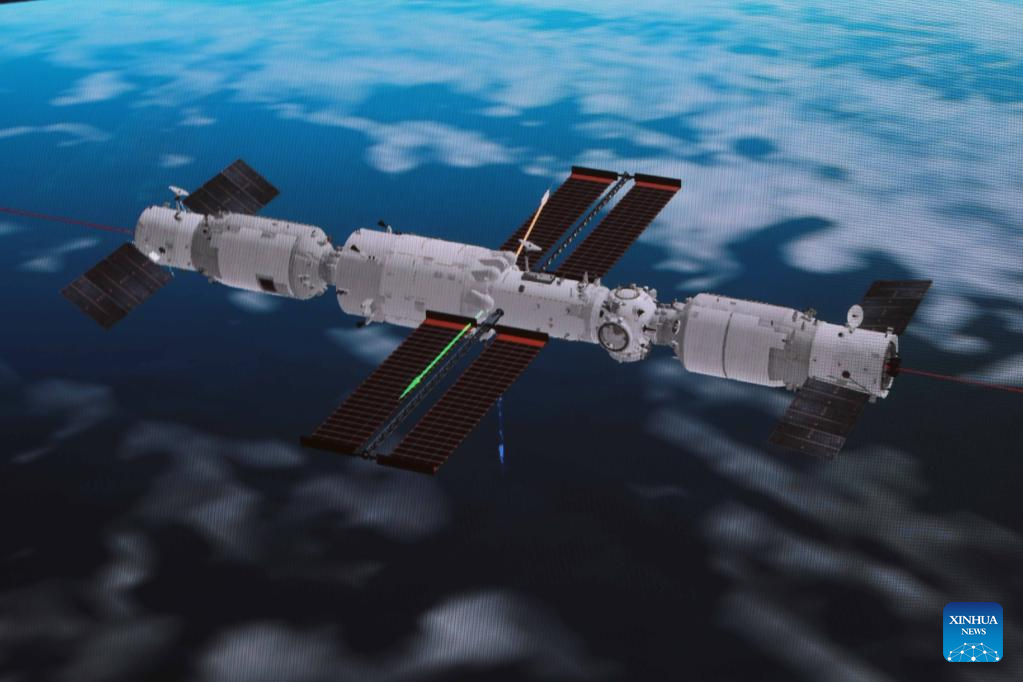
This simulated image captured at Beijing Aerospace Control Center on May 10, 2022 shows China's cargo spacecraft Tianzhou-4 docking with the combination of the space station core module Tianhe and the Tianzhou-3 cargo craft. China's cargo spacecraft Tianzhou-4, carrying supplies for the upcoming Shenzhou-14 crewed mission, successfully docked with the combination of the space station core module Tianhe and the Tianzhou-3 cargo craft on Tuesday, according to the China Manned Space Agency. (Xinhua/Guo Zhongzheng)
WENCHANG, Hainan, May 10 (Xinhua) -- China launched cargo spacecraft Tianzhou-4 on Tuesday to deliver supplies for its space station, which is scheduled to wrap up construction this year.
The Long March-7 Y5 rocket, carrying Tianzhou-4, blasted off at 1:56 a.m. Beijing Time from the Wenchang Spacecraft Launch Site in the southern island province of Hainan, according to the China Manned Space Agency.
After around 10 minutes, Tianzhou-4 separated from the rocket and entered its designated orbit. At 2:23 a.m., the solar panels of the cargo craft unfolded and began working.
At 8:54 a.m., Tianzhou-4 completed a computer-orchestrated rendezvous and docking at the rear docking port of the Tianhe core module.
On April 20, the Tianzhou-3 cargo craft separated from the rear docking port of Tianhe and docked with its front docking port.
Following Tianzhou-4's docking, the two cargo crafts are docked at the two ends of the Tianhe core module to form a linear shape, waiting for the arrival of the Shenzhou-14 crew members.
Measuring 10.6 meters in length and with a maximum diameter of 3.35 meters, the Tianzhou-4 cargo ship carries around 6 tonnes of goods and materials and 750 kg of propellant for the space station complex.
Like previous cargo flights, Tianzhou-4 mainly carries three categories of supplies, including six-month living supplies for the Shenzhou-14 mission's three astronauts, spare parts for space station maintenance, and space research equipment and sample materials, said Bai Mingsheng, chief designer of Tianzhou cargo craft from the China Academy of Space Technology.
He said Tianzhou-4's carrying capacity of dry cargo increased by 300 kg than the previous cargo ships. Meanwhile, based on the astronauts' in-orbit living and working experience, the team made some tweaks to the cargo storage, providing more convenience for the astronauts in detail.
For instance, different supplies have colored tags, such as green for food, so astronauts can quickly identify the parcels.
Bai said equipment for three research projects also arrived at the space station with Tianzhou-4 and they were selected from across China.
China plans to complete the in-orbit construction of its space station by the end of 2022, and a total of six missions are planned for this year.
Following the launch of Tianzhou-4, the Shenzhou-14 crewed spacecraft will arrive in June, the lab module Wentian in July, the lab module Mengtian in October, and then the Tianzhou-5 cargo craft and the Shenzhou-15 crewed spaceship later this year.
The two lab modules and the core module will form a T shape to complete the in-orbit construction of China's space station.
Tuesday's launch is the 22nd mission of China's manned space programs and the 420th mission of the Long March rocket series. ■



